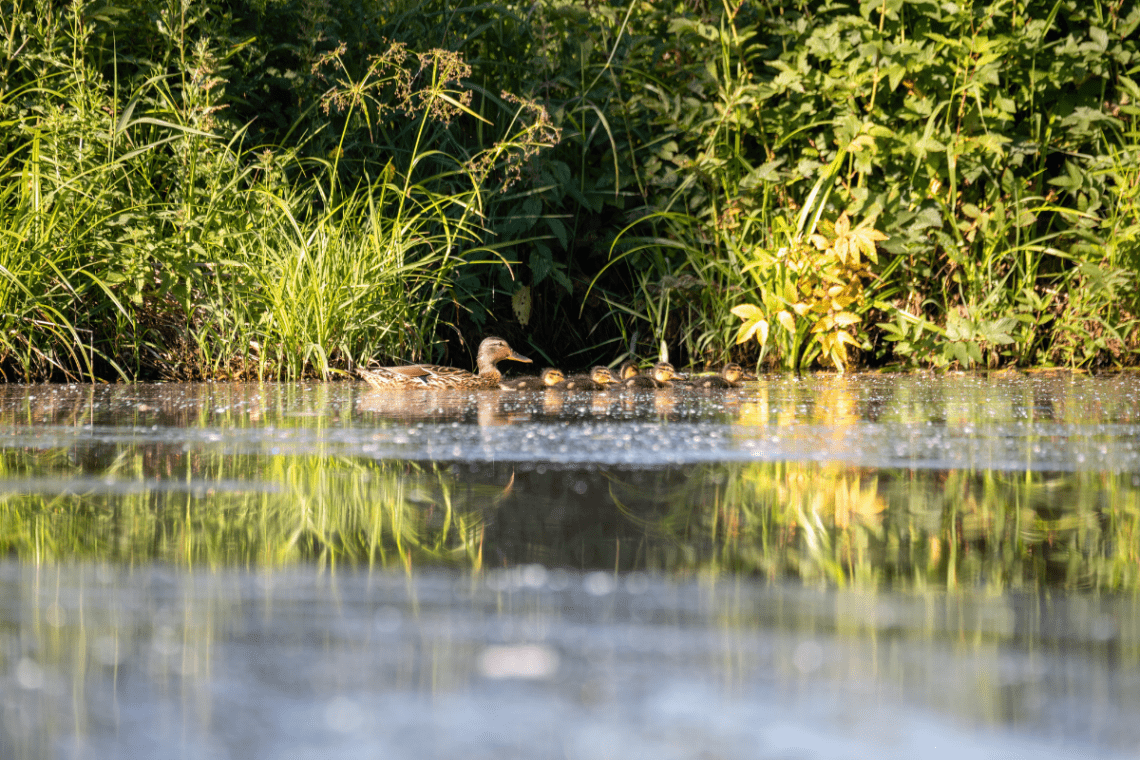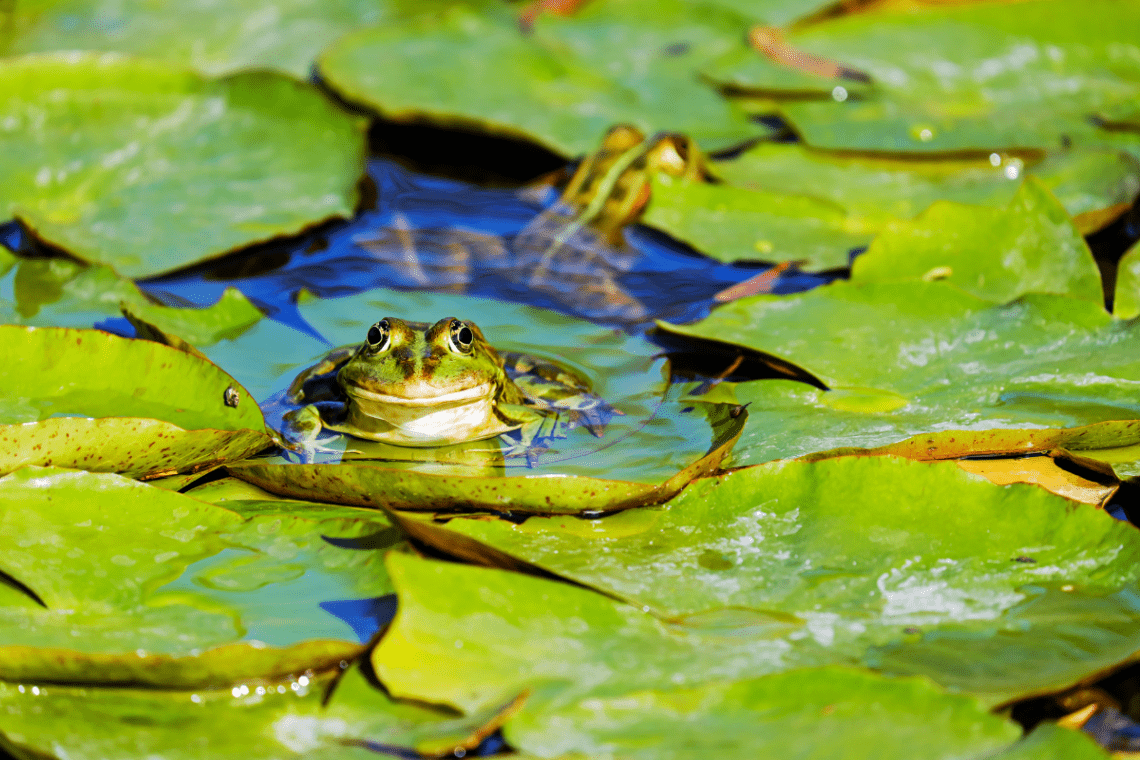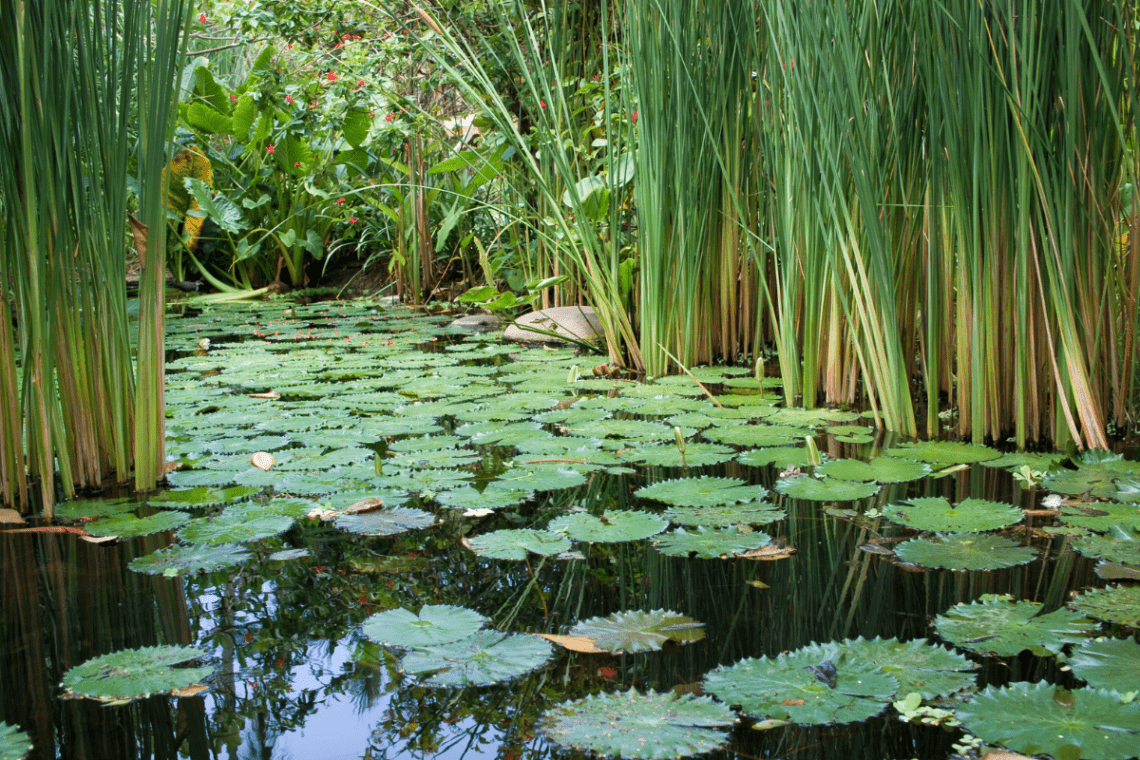When considering the creation of a wildlife pond, one of the first decisions is determining the ideal depth. The depth of your pond is a key aspect, not just for aesthetic appeal, but more importantly for the survival and health of the pond’s inhabitants – pond plants and wildlife.
Keep reading to discover the answer to the common question, “how deep should a wildlife pond be“, along with insights and expert advice on creating the perfect wildlife pond.
Key Takeaways
- The depth of a wildlife pond is crucial for supporting diverse habitats.
- Varying depths within a pond can help maintain water quality and protect local wildlife.
- A pond’s design should include considerations for wildlife, plants, and overall ecosystem health.
Determining Appropriate Pond Depth

Creating a wildlife pond in your garden can boost local pond ecosystems, but it’s important that you determine the correct depth to support seasonal variability and the needs of different species.
Basic Depth Recommendations
The ideal depth for a wildlife pond varies depending on its size, the local climate and the types of wildlife you want to attract. Generally, a mix of shallow areas (around 15-30 cm deep) and at least one deeper section (around 60 cm or more) is recommended.
A maximum depth of about 1 metre is often sufficient for most garden wildlife ponds, ensuring ease of maintenance and safety, while still offering a diverse habitat. This variety caters to different species’ needs, providing habitats for a range of aquatic plants and animals.
Seasonal Considerations
- Summer: During warm and hot weather, shallow ponds can warm up quickly, promoting algae growth. So, a part of your pond should be deeper to maintain a cooler, stable temperature, which is vital for the health of aquatic life.
- Winter: During winter, a pond with deep water is less likely to freeze completely, protecting the inhabitants below the ice. Aim for a depth that prevents the pond from freezing all the way through, to ensure that amphibians and other creatures can survive the harsher conditions. It is important to note that this varies significantly with geographic location, local weather patterns, and your pond winterisation efforts.
Taking into account these seasonal factors is essential when you are planning your wildlife pond to ensure it remains a safe place for wildlife year-round.
Designing Your Pond for Wildlife and Plant Life

To create thriving wildlife ponds, you need to design a habitat that caters to the needs of both plants and wildlife, offering shelter, food sources, and breeding grounds.
Creating Varied Habitats
Your wildlife pond will become a bustling hub of activity by incorporating various depths and features. Shallow areas are crucial for wildlife such as amphibians and birds; frogs and newts use them for breeding, while birds may use them for bathing and drinking. To prevent algae growth from overtaking your pond, include oxygenating plants which can help keep the water clear, benefiting both the visual appeal and health of your pond’s ecosystem.
On the other hand, deeper zones (no less than 30 cm) can provide refuge for fish and other aquatic life, protecting them from predators and harsh weather. This depth is also less likely to freeze completely in winter, offering a safe haven for pond life during cold spells.
Selection of Plants
Careful selection of pond plants enhances the ecological balance of your wildlife garden pond. Start by choosing a range of marginal plants such as rushes and water irises to plant around the pond edge that can provide excellent cover for amphibians and insects like pond skaters. To add vertical layers of habitat, incorporate floating plants like water lilies, which offer shade and reduce algae by limiting sunlight penetration.
For the best results, aim for a mixture of pond plants, including oxygenating plants and those that flower at different times of the year, ensuring that your pond remains vibrant and supportive for its inhabitants through all seasons. Remember to address algae growth, which can be reduced by the nutrient uptake of these carefully selected plants.
Maintaining Water Safety

Ensuring your pond’s health and the safety of its inhabitants, as well as people around it, requires careful attention to the water’s origin, treatment, and the implementation of essential safety measures.
For both wildlife and personal safety, take the following measures:
- Pond Safety: For young children, implement barriers or consider building raised ponds to prevent accidental falls. Create gentle slopes rather than steep sides around the edge to provide easy exit points for wildlife and to ensure safety if someone falls in.
- Aquatic Life Safety: Use a pump to circulate water and maintain oxygen levels, critical for the health of small fish and other aquatic creatures. Filters are also vital in keeping the water clear of debris and maintaining a balanced ecosystem, especially if you have large fish which produce more waste. Using tap water may require adjustments to suit aquatic life.
- Wildlife Considerations: Stepping stones and marginal plants can provide safe areas for beneficial flying insects and creatures. Avoid overcrowding with fish which can deplete oxygen levels and affect water quality.
Enhancing Your Garden with a Professionally Designed Wildlife Pond

While the appeal of undertaking a DIY project on your own is understandable, the benefits of having professional help are undeniable. With a focus on custom designs, quality construction, and ongoing support, Ponds by Michael Wheat ensure that your wildlife pond is a beautifully integrated, ecologically sound addition to your garden. This professional touch enhances your garden, making it not just a space for relaxation but a haven for biodiversity.
Design Expertise
Professional pond designers combine aesthetic appeal with ecological functionality, ensuring that your pond not only looks picturesque but also supports a vibrant ecosystem. Their expertise allows for the incorporation of subtle design elements that might not be immediately obvious to the DIY enthusiast. These elements are crucial for creating diverse habitats within your pond, catering to a wide range of wildlife and plant species.
Tailored to Your Garden’s Ecosystem

Every garden has a unique ecosystem, and understanding its intricacies is key to creating a wildlife pond that thrives. Professionals bring a refined approach, considering factors like garden size, existing flora and fauna, and sunlight exposure, along with wind and weather patterns. This bespoke approach ensures that your pond integrates seamlessly into your garden, enhancing its natural beauty and ecological health.
High-Quality Construction and Materials
The longevity and safety of your garden pond significantly depends on the quality of materials used and the construction techniques used. Professionals ensure the use of durable, high-quality materials that stand the test of time, providing a safe and stable habitat for inhabitants. Proper construction avoids common pitfalls seen in DIY ponds, such as leaks in the pond liner or structural failures, ensuring your pond remains a focal point of your garden for many years.
Ongoing Guidance & Maintenance
Perhaps one of the most valuable aspects of choosing professional service is the continued support and advice offered post-construction. Whether it’s seasonal pond maintenance, enhancing the pond’s biodiversity, or troubleshooting any issues, having expert advice on hand can make all the difference. This level of support can help maintain the health and vibrancy of your pond, an aspect often overlooked in the planning of DIY projects.
Don’t let the intricacies of pond design and construction hold you back. With Ponds by Michael Wheat, your journey to a captivating garden feature is in expert hands. Contact our team of experts today for a consultation and to learn how we can tailor a new pond to the unique ecosystem of your garden.
Frequently Asked Questions

1. Are there any legal restrictions on wildlife garden pond depth?
In most cases, there are no specific legal restrictions on the depth of wildlife garden ponds in private gardens. However, a useful rule of thumb is ensuring your pond is less than 20 inches deep and covers no more than 10 percent of your property.
It’s always wise to check local regulations, especially if you’re planning a large or deep pond, as there may be safety regulations or pond planning permissions required. Additionally, if your pond could affect local water levels or wildlife, it’s important to consult with environmental agencies.
2. How does pond depth influence the presence of aquatic plants and overall pond health?
The depth of your pond is critical for supporting a range of aquatic plants; shallow areas allow sunlight to reach the bottom, encouraging plant growth, which in turn benefits water quality and pond biodiversity.
3. Can a wildlife pond be too deep?
Yes, a wildlife garden pond can be too deep. While deeper ponds can support a wider range of species, there is a point where additional depth may not provide significant ecological benefits and could complicate maintenance.
Excessively deep ponds may not warm up sufficiently, affecting the growth of aquatic plants and reducing the habitat’s suitability for certain wildlife species. Deeper ponds also increase the risk of stratification, where the water layers don’t mix well, leading to poor oxygen levels in lower layers and potentially harming aquatic life.
4. Can pond depth affect the water’s pH level?
The depth of a pond can impact its pH level indirectly by influencing temperature and biological activity. Deeper water tends to have more stable temperatures and can support different biochemical processes compared to a more shallow, small pond.
These processes can affect the accumulation of organic matter and the release of gases like carbon dioxide, which in turn can influence pH levels. Regular monitoring and management are essential to maintain a balanced pH suitable for a diverse range of pond life.
PS: Have a look at our guide How to Clean a Wildlife Pond for more information and top tips.
5. Can the depth of a pond deter predators?
Yes, the depth of garden ponds can help deter predators. For example, a deeper section in the pond water can provide a safe haven for fish and amphibians, making it harder for predators like cats or herons to reach them. Additionally, incorporating hiding spots such as underwater caves or dense plant cover in deeper areas can offer further protection for pond wildlife.